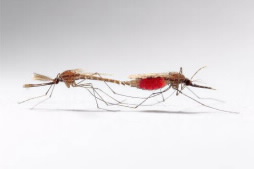EMBARGOED FOR RELEASE | August 19, 2012
Meddling with male malaria mosquito “mating plug” to control an epidemic
Note to journalists: Please report that this research was presented at a meeting of the American Chemical Society.
PHILADELPHIA, Aug. 19, 2012 — Using information about the unique mating practices of the male malaria mosquito ― which, unlike any other insect, inserts a plug to seal its sperm inside the female ― scientists are zeroing in on a birth-control drug for Anopheles mosquitoes, deadly carriers of the disease that threatens 3 billion people, has infected more than 215 million and kills 655,000 annually.
They reported today at the 244th National Meeting & Exposition of the American Chemical Society on development of an approach for screening substances that could prevent formation of the plug, thus preventing mosquitoes from reproducing and spreading malaria.
Media Contact
During Aug. 17-23 the contacts can be reached at 215-418-2086.
Michael Bernstein
202-872-6042
m_bernstein@acs.org
Michael Woods
202-872-6293
m_woods@acs.org
Richard H. G. Baxter, Ph.D., professor of chemistry at Yale University, who presented the report, described the search for a new birth-control strategy for mosquitoes. Anopheles gambiae mosquitoes mate in airborne swarms, but only females bite and feed on blood from people ― the bite that transmits the malaria parasite to humans. To ensure mating success, an Anopheles male produces a special “mating plug” to seal its sperm inside the female’s mating chamber. The Yale researchers purified the specific enzyme, a transglutaminase, responsible for coagulating another protein called Plugin within the male’s seminal fluid to form the plug. They went on to purify the Plugin protein and reconstitute the coagulation reaction in the lab, setting the stage to search for chemicals that inhibit this reaction.
The technology is based on a discovery about the plug in 2009 by Flaminia Catteruccia, Ph.D., then at Imperial College London. Catteruccia’s research detailed the biochemical composition of the plug, identified the transglutaminase enzyme and showed that blocking the enzyme prevents females from storing sperm to fertilize their eggs. Catteruccia, now at the Harvard School of Public Health, is collaborating with Baxter and his team at Yale to translate that knowledge into technology to put a dent in the population of malaria mosquitoes.
“We have completed the necessary groundwork to start screening for chemicals that inhibit the enzyme,” Baxter explained. “I think that there’s a good chance that we will find a compound because there are many existing compounds that inhibit other transglutaminases. Ideally, it would be a substance that could be fed to males, sterilizing them so that they mate but no offspring result. It’s a well-established biological insect-control technology called the sterile insect technique and has been used for decades.”
The sterile insect technique was first used to control the screwworm fly in the southern United States and other areas. The screwworm fly was once responsible for hundreds of millions of dollars in losses to the cattle industry and consumers. The approach is used against tsetse flies in Africa that transmit sleeping sickness and can be effective against mosquitoes, which mate only once or twice in their lifetime. Male mosquitoes would be reared under controlled conditions, fed a transglutaminase inhibitor and released to mate with wild females, reducing the population without the use of insecticides.
The new approach may help to deploy the sterile insect technique against mosquitoes by overcoming previous logistical and environmental concerns. “By developing a chemical that is specific to the Anopheles mosquito and applied in a contained environment, we can minimize both cost and environmental impact,” says Baxter. The technology is compatible with other methods such as genetic modification, pioneered by the British firm Oxitec.
The sterile insect technique is a different approach than traditional malaria control strategies, such as the indoor spraying of insecticides and the use of insecticide-treated bed nets. “Mosquitoes are adapting to the traditional control measures,” warns Baxter. “They are becoming resistant to the commonly used insecticides such as DDT and pyrethroids, and they are avoiding bed nets by biting during the day and out-of-doors. The sterile insect technique moves us away from trying to deliver chemicals to female mosquitoes by spreading them around people. Instead, we feed a chemical to the male, and he finds the females for us.”
The scientists acknowledge support from the National Institute of Allergy and Infectious Diseases (NIAID Career Development Award, K22AI085112-01).
To automatically receive news releases from the American Chemical Society contact newsroom@acs.org.
###


